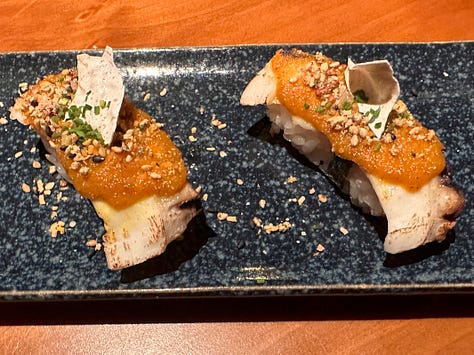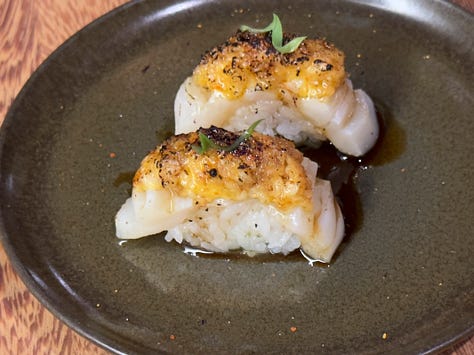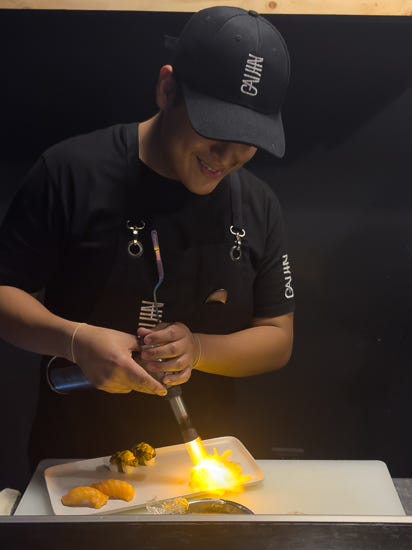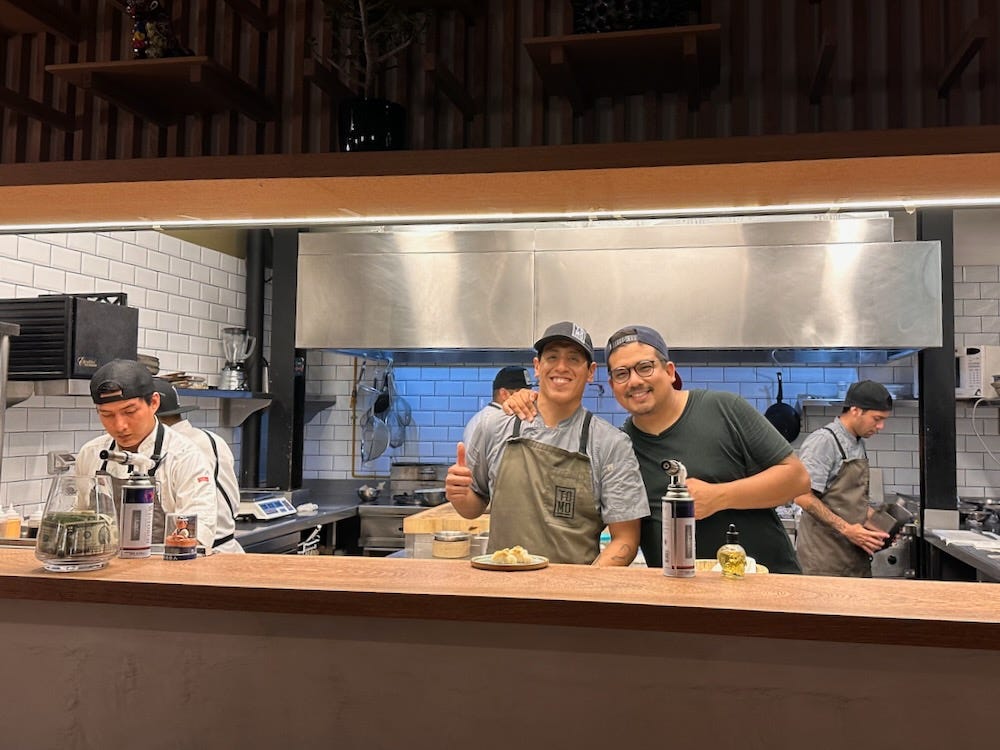Nikkei Nights
Grab a seat at the sushi bar
In this post, I’ll tell you about Nikkei food and why it’s one of the best dinner options when you’re in Lima. Even if you’re not planning to visit Lima anytime soon, I hope you’ll enjoy this dive into the fascinating world of Nikkei cuisine.
What is Nikkei?
Simply put, Nikkei is Peruvian-Japanese fusion. Nikkei is a true blend of Peruvian and Japanese ingredients, techniques, and ideas. I think the best way to see all this come together is to visit one of the premiere Nikkei restaurants in Lima (my personal shortlist at the end of the post).
I used to think that the repertoire of Nikkei dishes was relatively small, centered around tiradito and acevichado rolls. However, as I began digging deeper, visiting a new Nikkei restaurant each week, I began seeing a huge influx of new ideas as a new generation of Itamae, the Japanese honorific for chef, pushes Nikkei cuisine forward.
Why Nikkei for dinner?
In Peru, lunch is king. Many Peruvians eat big lunches and smaller dinners. As a result, you have much fewer options for dinner than for lunch. Even in the heart of Miraflores, it’s sometimes difficult to know what to eat for dinner in Peru. Nikkei turns out to be the perfect option for dinner in Lima. Nikkei restaurants also tend to cluster in Miraflores and San Isidro, both safe neighborhoods, even at night.
Nikkei food is perfect for dinner because a typical Nikkei menu has an array of small, medium, and large dishes to choose from. You can order until you’re full or 80% full as is recommended for healthy eating.
My Number One Advice for Nikkei Food
I recommend that you sit at the bar for a more intimate experience. When you sit down, you’ll immediately be greeted with a display of the fresh fish and seafood of the day. However, it’s the live-action that will really draw you in. It’s always a good show. You can see the chef masterfully slicing through fish and assembling a variety of rolls, and nigiri from a wide range of ingredients. And with Nikkei, more often than not, there’s fire.
I recommend that you strike up a conversation or at least say hi. You can even ask a couple of questions when the chef isn’t busy. It’s a perfect time to practice your Spanish. Many of the chefs will also speak some English. As a bonus, once you get to know the chef, they’ll offer to make custom rolls or nigiri based on your preferences.
How We Order
I usually like to say a little about our personal tastes so that you can get a sense of how our recommendations mesh with your tastes. For Nikkei food, I generally want to try as many flavors as possible so that means a lot of nigiri and half maki rolls instead of full rolls. I seldom order nigiri in the United States. The nigiri in Peru tends to be smaller but more intricate, with many components coming together in one bite.

For makis, I generally avoid rolls with cream cheese. It can be done well, but I’m still reeling from the makis in Mexico City which were stuffed with more cream cheese than fish. Also, this restriction helps make the number of options more manageable. If I really enjoy a restaurant and want a last bite, I will occasionally try a maki with cream cheese.
We almost always order the acevichado, the most classic maki roll which is smothered with a sauce made from the marinade in ceviche. The acevichado at each restaurant is slightly different and provides a basis for comparing restaurants.
I’ve recently started ordering tiradito more. My early experience with tiradito was that it can often be too saucy and as a result, cloyingly sweet. I was probably just going to the wrong Nikkei restaurants.
You generally get more fish for the same money when you order ceviche. However, when I started going alone, the delicate portion of tiradito became a plus in my book. Last but not least, I always recommend only eating ceviche for lunch. I consider tiradito to be a type of ceviche, but it seems more acceptable to order tiradito as part of dinner than it is to order ceviche for dinner.
I often don’t even order a main dish. We’ve tried ordering ramen, but my feeling is that the ramen we’ve had in Lima is not yet on the same level as the sushi.

We generally order in two waves. We’ll order a couple of nigiri and perhaps a tiradito “por ahora” (for now) and then order more based on our impressions of the initial bites. We try not to be too annoying, ordering only one or two bites at a time (especially if the place is busy).
On a second visit, if we’re at a place that’s particularly good at sourcing fish and seafood, we’ll order sashimi. Usually for the first visit, I want to taste the full range of flavors the chef is able to bring together. That’s why we go for smaller bites.
What to Order



To start off your Nikkei experience, I would recommend ordering these:
Tiradito
2-3 Nigiri
Acevichado roll
The Nigiri section is currently my favorite part of the menu. I think it’s the place where the chef’s creativity really shines. It’s impressive how many layers of flavor Nikkei chefs can pack in a single bite.
If you’re still hungry, more makis or a main dish. Nikkei restaurants also now often have a few bao sandwiches to choose from. At a Nikkei restaurant, a main dish will run a little smaller than at a typical Peruvian restaurant. Some Nikkei restaurants will have a couple of choices for dessert. Other, more traditional restaurants may only have one choice or nothing at all!
Where to Try Nikkei Cuisine
I probably went to more restaurants for this story than for any other one. Here’s my shortlist of restaurants to try (remember, try to sit at the bar if you can).
This article focuses on newer Nikkei restaurants, but Maido represents Nikkei cuisine on the world’s top restaurant list. However, you don’t go to Maido for Acevichado. If you are able to splurge, Mitsuharu Tsumura offers his singular vision of Nikkei in his ever-evolving tasting menu. It’s simply one of those meals that you’ll remember forever.
Next on my shortlist would be Tomo (Miraflores), Shizen (San Isidro), Fan (Miraflores), and Gaijin (Miraflores). I’ve been to all of these multiple times now.
Tomo is probably my favorite place for ordering nigiri and rolls. Fan offers an Omakase option that I’m eager to try. Gaijin offers an affordable tasting menu that doesn’t require a reservation (summary coming soon to my restaurant notes).
Matsuei, Osaka, Costanera 700, and Sutorīto Māketto are also worth trying. I’ve only been to them one time each.
Many cevicherías in Lima also offer select nikkei items like acevichado, tiradito, and rolls on the menu.
Finally, if you’re in Cusco, head to Limo near Plaza de Armas for quality Nikkei.






Great article! I wish I had read it before I ventured into Nikkei in Lima, especially the idea of half nigiri’s to allow room for more to variety. Also loved the tiradito at Tomo, although the most memorable one we had was at Mérito in Barranco. Can’t wait to return.
Thanks for the recommendations. Looking forward to heading back down to Peru.
Cheers